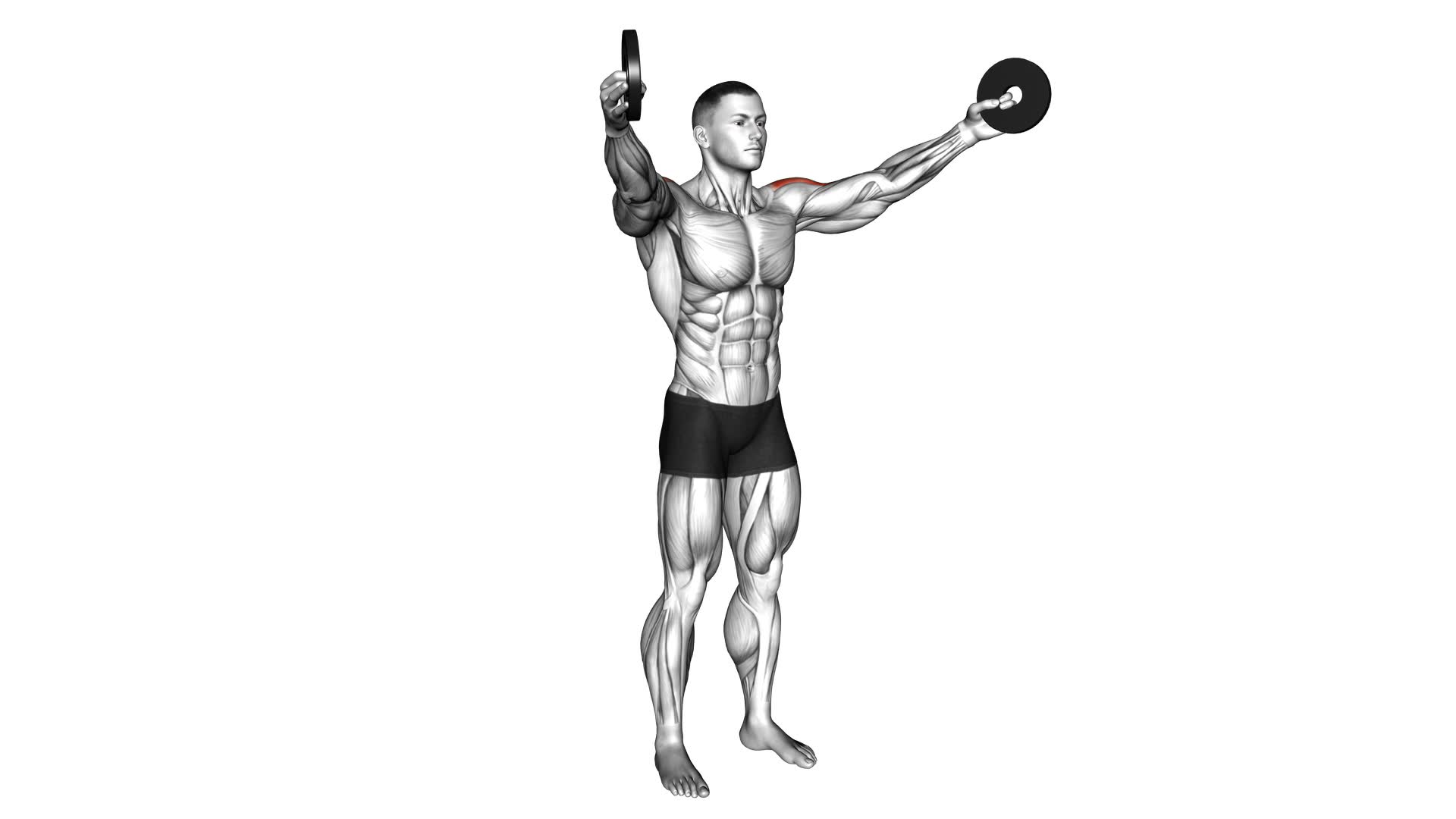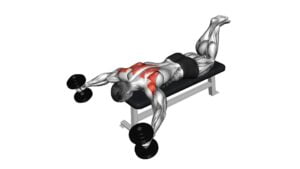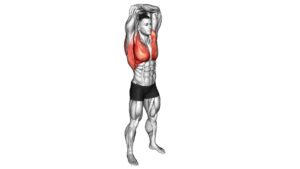Weighted Full Can Exercise (male) – Video Exercise Guide & Tips

Are you looking to add some extra intensity to your workouts? The weighted full can exercise is just what you need!
Watch This Exercise Video
In this video exercise guide, we will show you the proper form and technique to perform this exercise effectively. You'll also learn about the equipment needed and common mistakes to avoid.
Plus, we'll share tips for progressing and increasing the intensity of the exercise.
Get ready to take your fitness routine to the next level!
Key Takeaways
- The weighted full can exercise strengthens and tones the shoulder muscles, including the deltoids.
- It engages the rotator cuff muscles, improving shoulder stability and preventing injuries.
- The exercise targets the muscles in the upper back, improving posture and preventing upper back pain.
- There are variations of the exercise that can target different muscle groups and achieve specific fitness goals.
Benefits of the Weighted Full Can Exercise
You can achieve various benefits from performing the Weighted Full Can Exercise.
This exercise is highly versatile, with several variations that allow you to target different muscle groups and achieve specific fitness goals.
One of the primary benefits of the Weighted Full Can Exercise is its ability to strengthen and tone the shoulder muscles, specifically the deltoids. By using weights or resistance bands, you can increase the intensity of the exercise and effectively engage the muscles.
Additionally, this exercise also targets the rotator cuff muscles, which play a crucial role in stabilizing the shoulder joint and preventing injuries. Strengthening these muscles can improve your overall shoulder stability and reduce the risk of common shoulder problems.
The Weighted Full Can Exercise also engages the muscles in your upper back, including the trapezius and rhomboids, helping to improve posture and prevent upper back pain.
Proper Form and Technique for the Exercise
To ensure proper form and technique for the Weighted Full Can Exercise, focus on maintaining a stable and controlled movement throughout the exercise. Proper form is crucial to prevent injury and maximize the effectiveness of the exercise.
Start by standing with your feet shoulder-width apart and holding a dumbbell in each hand. Keep your arms straight down by your sides, palms facing forward. Slowly raise both arms out to the sides, keeping them straight, until they're parallel to the floor. This is your starting position.
As you lift your arms, focus on engaging your shoulder muscles and keeping your core stable. Avoid using momentum or swinging your arms to lift the weights. Instead, use a slow and controlled movement, keeping your shoulders relaxed and your elbows slightly bent.
At the top of the movement, pause for a moment and squeeze your shoulder blades together to fully engage the muscles. Then, slowly lower the weights back down to the starting position, again maintaining control and stability throughout the movement.
Remember to breathe steadily throughout the exercise, inhaling as you lift the weights and exhaling as you lower them. By following these proper form guidelines, you can ensure that you're targeting the correct muscles and avoiding unnecessary strain or injury.
Equipment Needed for the Weighted Full Can Exercise
To perform the Weighted Full Can Exercise, you'll need some essential equipment.
The main equipment required for this exercise is weighted cans, which can be easily found at your local gym or purchased online. However, if you don't have access to weighted cans, there are alternative options such as water bottles or dumbbells that can be used instead.
Essential Equipment for Exercise
Using weighted cans is essential for performing the Weighted Full Can Exercise. When it comes to equipment options, you have a few choices. Dumbbells are a popular choice as they provide a secure grip and allow for easy weight adjustment. You can also use water bottles or filled milk jugs if you don't have access to dumbbells.
Safety precautions are important to consider when using weighted cans. Make sure that the cans are securely closed to prevent any spills or leaks during the exercise. Additionally, start with lighter weights and gradually increase the resistance as you build strength and confidence.
Always maintain proper form and listen to your body to avoid any injuries. Remember to consult a professional before starting any new exercise program to ensure it's suitable for your fitness level and health condition.
Alternatives to Weighted Cans
You can use different types of equipment as alternatives to weighted cans for the Weighted Full Can Exercise. If you don't have access to weighted cans, don't worry! There are plenty of weight alternatives and DIY options you can try. Here are some ideas to consider:
- Water bottles filled with sand or water
- Dumbbells or barbells
- Resistance bands or tubes
- Backpack filled with books or weights
- Household items like soup cans or bags of rice
These alternatives will provide the necessary weight to challenge your muscles and make the exercise effective.
Now that you know you don't need weighted cans specifically, let's move on to the step-by-step guide to performing the Weighted Full Can Exercise.
Step-by-Step Guide to Performing the Exercise
To perform the Weighted Full Can Exercise correctly, it's crucial to focus on proper form techniques. This includes maintaining a neutral spine, engaging your core, and keeping your elbows at a 90-degree angle throughout the movement.
It's also important to avoid common mistakes such as using too heavy of a weight or swinging your arms.
Proper Form Techniques
To perform the Weighted Full Can Exercise correctly, ensure that you have a firm grip on the dumbbells. This exercise offers several benefits, including strengthening the shoulders and upper back, improving posture, and increasing shoulder stability.
Here are some variations you can try to target different areas:
- Seated Variation: Sit on a bench or stability ball while performing the exercise to engage your core muscles.
- Single Arm Variation: Perform the exercise with one arm at a time to isolate and strengthen each shoulder individually.
- Resistance Band Variation: Use a resistance band instead of dumbbells to add variety and challenge to the exercise.
- Standing Variation: Stand on one foot while performing the exercise to improve balance and stability.
- Incline Variation: Perform the exercise on an inclined bench to target the upper chest muscles.
By mastering proper form and exploring different variations, you can maximize the effectiveness of the Weighted Full Can Exercise.
Now let's move on to the next section and discuss common mistakes to avoid.
Common Mistakes to Avoid
Avoiding common mistakes is crucial when performing the Weighted Full Can Exercise correctly. To ensure you get the most out of this exercise, it's important to be aware of the common pitfalls and how to avoid them.
One mistake to avoid is using too much weight. Start with a lighter weight and gradually increase as you become more comfortable with the exercise.
Another mistake isn't maintaining proper form throughout the movement. Keep your back straight, engage your core, and avoid swinging or using momentum to lift the weight.
Lastly, be mindful of common Weighted Full Can Exercise injuries such as shoulder strains or rotator cuff tears. If you feel any pain or discomfort, stop the exercise and consult a healthcare professional.
Benefits of This Exercise
Get ready to experience the benefits of the Weighted Full Can Exercise with this step-by-step guide. This exercise offers numerous advantages for your upper body strength and stability. Here are some key benefits you can expect:
- Increased shoulder and rotator cuff strength
- Improved shoulder stability and mobility
- Enhanced upper body muscular endurance
- Targeted activation of the deltoids, trapezius, and rhomboids
- Potential for variations to target different muscle groups
By incorporating the Weighted Full Can Exercise into your routine, you can strengthen your shoulders, improve your posture, and enhance your overall upper body strength. These benefits make it an excellent exercise choice for athletes, weightlifters, and fitness enthusiasts alike.
Now that you understand the advantages, let's explore the common mistakes to avoid during the weighted full can exercise.
Common Mistakes to Avoid During the Weighted Full Can Exercise
Make sure to steer clear of these common mistakes when performing the Weighted Full Can Exercise.
One of the most common mistakes is using improper technique. It's important to maintain proper form throughout the exercise to prevent injury and maximize the benefits.
One mistake to avoid is using too much weight. Start with a lighter weight and gradually increase as you become more comfortable and confident with the exercise.
Another mistake is rushing through the movement. Take your time and focus on the muscle contraction and extension.
It's also important to avoid using momentum to lift the weight. Instead, engage the targeted muscles and use controlled movements.
Lastly, make sure to keep your core engaged and maintain proper posture throughout the exercise.
By avoiding these common mistakes, you can ensure that you're getting the most out of the Weighted Full Can Exercise.
Now, let's move on to some tips for progressing and increasing the intensity of the exercise.
Tips for Progressing and Increasing the Intensity of the Exercise
To progress and increase the intensity of the Weighted Full Can Exercise, you can incorporate variations and gradually increase the weight used. Here are some tips to help you progress and make the exercise more challenging:
- Increase the weight gradually: Start with a weight that challenges you but allows you to maintain proper form. As you become comfortable with the exercise, gradually increase the weight to continue challenging your muscles.
- Use different variations: You can vary the exercise by changing the grip or hand positioning. For example, you can try a neutral grip or a pronated grip to target different muscles in your shoulders and arms.
- Incorporate supersets: To increase the intensity, you can pair the Weighted Full Can Exercise with another exercise targeting the same muscle group. This will help you work the muscles to fatigue and promote muscle growth.
- Decrease rest time: Another way to increase the intensity is by decreasing the rest time between sets. This will keep your heart rate elevated and challenge your cardiovascular system.
- Increase the number of reps or sets: Gradually increase the number of reps or sets you perform during each workout. This will help you build endurance and strength over time.
Frequently Asked Questions
How Many Sets and Repetitions Should I Do for the Weighted Full Can Exercise?
To achieve optimal results with the weighted full can exercise, it's essential to focus on sets, repetitions, technique, and form. Finding the right balance is key.
Start with a moderate number of sets, such as three, and aim for 8-12 repetitions per set. This will help build strength and muscle endurance.
Remember to maintain proper technique and form throughout the exercise to avoid injury and maximize the benefits.
Can I Perform the Weighted Full Can Exercise if I Have Shoulder Pain or Injury?
If you have shoulder pain or injury, it's important to modify the weighted full can exercise to avoid further discomfort. Consult with a healthcare professional or a qualified trainer to learn the appropriate modifications for your condition.
It's worth noting that the weighted full can exercise, when performed correctly, can help strengthen the muscles around the shoulder joint, improve stability, and enhance overall shoulder function.
However, always prioritize your safety and listen to your body's signals.
Is It Necessary to Use Weights for the Weighted Full Can Exercise, or Can I Use a Resistance Band Instead?
You don't necessarily have to use weights for the weighted full can exercise. Instead, you can opt to use a resistance band.
Using resistance bands for the weighted full can exercise has its benefits. Resistance bands provide constant tension throughout the movement, which can help strengthen your muscles and improve stability. They also allow for a wider range of motion and are more versatile than weights.
Can the Weighted Full Can Exercise Help With Improving Posture?
The weighted full can exercise can be beneficial for improving posture. By engaging the muscles in your shoulders, upper back, and core, this exercise helps strengthen the muscles that support proper alignment.
It can also promote shoulder stability and reduce the risk of injury.
Incorporating weights into the exercise adds an extra challenge and increases the potential benefits.
Are There Any Modifications or Variations of the Weighted Full Can Exercise for Beginners or Individuals With Limited Shoulder Mobility?
If you're a beginner or have limited shoulder mobility, there are modifications and variations you can try for the weighted full can exercise. These modifications can help you ease into the exercise and prevent any strain or discomfort.
For beginners, you can start with lighter weights or even use resistance bands instead.
Individuals with limited shoulder mobility can try performing the exercise with a smaller range of motion or using a lighter weight to reduce strain on the shoulders.
Conclusion
The weighted full can exercise is a beneficial workout that targets the muscles in the shoulders and upper back. By maintaining proper form and technique, using the necessary equipment, and following a step-by-step guide, you can effectively perform this exercise.
Avoiding common mistakes and gradually increasing the intensity will help you progress and achieve better results. Incorporate the weighted full can exercise into your fitness routine to strengthen and tone your upper body.

Author
Years ago, the spark of my life’s passion ignited in my mind the moment I stepped into the local gym for the first time. The inaugural bead of perspiration, the initial endeavor, the very first surge of endorphins, and a sense of pride that washed over me post-workout marked the beginning of my deep-seated interest in strength sports, fitness, and sports nutrition. This very curiosity blossomed rapidly into a profound fascination, propelling me to earn a Master’s degree in Physical Education from the Academy of Physical Education in Krakow, followed by a Sports Manager diploma from the Jagiellonian University. My journey of growth led me to gain more specialized qualifications, such as being a certified personal trainer with a focus on sports dietetics, a lifeguard, and an instructor for wellness and corrective gymnastics. Theoretical knowledge paired seamlessly with practical experience, reinforcing my belief that the transformation of individuals under my guidance was also a reflection of my personal growth. This belief holds true even today. Each day, I strive to push the boundaries and explore new realms. These realms gently elevate me to greater heights. The unique combination of passion for my field and the continuous quest for growth fuels my drive to break new ground.







